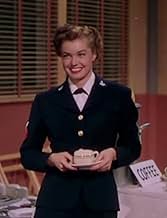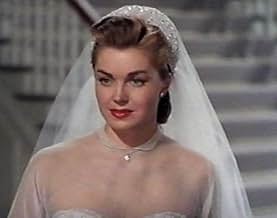IMDb RATING
5.7/10
614
YOUR RATING
Three women in three different situations report for induction at the Great Lakes Naval Training Station and end up roommates. What follows is a frothy and fun musical.Three women in three different situations report for induction at the Great Lakes Naval Training Station and end up roommates. What follows is a frothy and fun musical.Three women in three different situations report for induction at the Great Lakes Naval Training Station and end up roommates. What follows is a frothy and fun musical.
- Awards
- 1 win total
The DeMarco Sisters
- The Williams Sisters
- (as The De Marco Sisters)
Dorothy Abbott
- WAC
- (uncredited)
Bette Arlen
- Bridesmaid
- (uncredited)
- Director
- Writer
- All cast & crew
- Production, box office & more at IMDbPro
Featured reviews
This movie isn't terribly accurate as to actual Boot Camp life, they had MUCH more freedom than we did, but it was filmed at Great Lakes Naval Station about 10 years before I was stationed there in 1962-3. The barracks, the furnishings, everything in the background shots look just the way they did when I was there. We also lived in those same WWII temporary barracks. I thoroughly enjoy this movie every time I watch it just for the memories and to see those wonderful uniforms that I really liked! My favorite part of the movie each time is the Drill Team scene, they do some of the very same routines that we did when I was on the Boot Camp Drill Team at Bainbridge, Maryland in 1962.
Esther Williams is top-billed and dripping-wet as usual (an underwater ballet with two cloying kiddies is especially hard to take), but the truly frightening presence here is that of Vivian Blaine, fast on the heels of her Broadway triumph in "Guys and Dolls." She had been a likeable but unremarkable singer at 20th in the 40s, then "G&D" gave her a new persona in the character of Adelaide, the adenoidal, Brooklynese nightclub dancer. Here she's Adelaide in all but name, and her rambunctiousness makes Betty Hutton look timid. Her overemphatic line readings and hoydenishness quickly become wearing, but you don't forget her.
Esther, who sang acceptably and had a nice comic sense in addition to her aquatic gifts, is a gracious presence and has more to act than usual. Here she's a headstrong rich girl who learns humility--not exactly a fresh idea, but it's spun out gracefully by screenwriter Isobel Lennart, and given some appealing feminist filigrees. The songs are OK, second-lead Joan Evans is dull, and the nearly two-hour running time feels padded out, especially with a couple of specialty numbers thrown in. But it's a decent Technicolor time-passer, with all that postwar Hollywood patriotism that seems to be coming back in vogue.
Esther, who sang acceptably and had a nice comic sense in addition to her aquatic gifts, is a gracious presence and has more to act than usual. Here she's a headstrong rich girl who learns humility--not exactly a fresh idea, but it's spun out gracefully by screenwriter Isobel Lennart, and given some appealing feminist filigrees. The songs are OK, second-lead Joan Evans is dull, and the nearly two-hour running time feels padded out, especially with a couple of specialty numbers thrown in. But it's a decent Technicolor time-passer, with all that postwar Hollywood patriotism that seems to be coming back in vogue.
A very dull musical, not comparable with what director Sidney Lanfield had made at 20th.Century Fox in the thirties. No wonder this was his last picture. An example of the difference between what the Freed unit and the Pasternak unit were doing at MGM at the time. Of course, Esther Williams was as beautiful as ever.
Even though I am a fan of Esther Williams, I found this film very uneven.
Skirts Ahoy! was released in 1952 when the U.S. was involved in the Korean conflict. The roles of women in society were changed significantly during WWII, which ended only about five years before. The country was adjusting quickly and creating social phenomena (the baby boom, the suburban real estate boom, and a search for equilibrium in the roles of the sexes) that would be studied for decades. Esther Williams, Vivian Blaine and Joan Evans play three Waves in training at the Great Lakes U.S. Naval Training Center. They are rather aggressive in pursuit of men--an attitude that many men would find off-putting, especially in the early 50s.
Barry Sullivan plays the navy physician that Esther Williams pursues. I found his performance drab, making it difficult to understand her fascination with him.
Vivian Blaine practically plays Miss Adelaide from Guys and Dolls here, a role she perfected on Broadway in 1950 and, later, in the film (1955).
Esther gets her moments in the pool, of course. As usual, the aqua routines are not really a part of the overall plot. And the studio managed to throw in a number of music and dance numbers that are the same way, so that Esther is an audience member during them. It's pretty remarkable that the local dinner club features Billy Eckstine. In a show on the base, we find Keenan Wynn, Debbie Reynolds, Bobby Van and a full selection of orchestra, drill teams, and choral groups.
The dance number featuring Debbie and Bobby was fun. Both are so fresh that their roles are uncredited. Singin' in the Rain was released in the same year, so who knew Debbie would be such a hit when Skirts Ahoy! came to theaters?
I particularly enjoyed the performances of the (5) DeMarco Sisters. Great harmonies, great energy.
The film has an improbable resolution, but the entire plot is merely a device to separate the swimming and musical numbers.
Skirts Ahoy! was released in 1952 when the U.S. was involved in the Korean conflict. The roles of women in society were changed significantly during WWII, which ended only about five years before. The country was adjusting quickly and creating social phenomena (the baby boom, the suburban real estate boom, and a search for equilibrium in the roles of the sexes) that would be studied for decades. Esther Williams, Vivian Blaine and Joan Evans play three Waves in training at the Great Lakes U.S. Naval Training Center. They are rather aggressive in pursuit of men--an attitude that many men would find off-putting, especially in the early 50s.
Barry Sullivan plays the navy physician that Esther Williams pursues. I found his performance drab, making it difficult to understand her fascination with him.
Vivian Blaine practically plays Miss Adelaide from Guys and Dolls here, a role she perfected on Broadway in 1950 and, later, in the film (1955).
Esther gets her moments in the pool, of course. As usual, the aqua routines are not really a part of the overall plot. And the studio managed to throw in a number of music and dance numbers that are the same way, so that Esther is an audience member during them. It's pretty remarkable that the local dinner club features Billy Eckstine. In a show on the base, we find Keenan Wynn, Debbie Reynolds, Bobby Van and a full selection of orchestra, drill teams, and choral groups.
The dance number featuring Debbie and Bobby was fun. Both are so fresh that their roles are uncredited. Singin' in the Rain was released in the same year, so who knew Debbie would be such a hit when Skirts Ahoy! came to theaters?
I particularly enjoyed the performances of the (5) DeMarco Sisters. Great harmonies, great energy.
The film has an improbable resolution, but the entire plot is merely a device to separate the swimming and musical numbers.
This post-WWII film is very dated. The women recruits sing a song about how 'women are nothing without a man'. If you can put this sort of sentiment in the context that it was created, this film has a few things to recommend it. There are a few good musical numbers, and lots of camp humour. It's hilarious that none of the military personnel are ever shown doing anything remotely militant. The Navy is depicted as a social event, with shows, synchronized swimming, dating, hijinks.
The DeMarco Sisters contribute a few nice moments to this brief, shallow movie. They harmonize nicely, and perform with enthusiasm.
The movie is a mildly entertaining snapshot of the early Fifties, when America was still preoccupied with the war even while it was starting to focus its gaze on the changing relationship between the sexes.
The DeMarco Sisters contribute a few nice moments to this brief, shallow movie. They harmonize nicely, and perform with enthusiasm.
The movie is a mildly entertaining snapshot of the early Fifties, when America was still preoccupied with the war even while it was starting to focus its gaze on the changing relationship between the sexes.
Did you know
- TriviaKathy Tongay, the little girl with whom Esther Williams swims in one sequence, died shortly before her sixth birthday just a year after the film was released, after suffering fatal internal injuries after her swimming coach father instructed her to make a dive from a 33-foot-high platform in Florida. (Her older brother Russell 'Bubba' Tongay, also appears in the sequence; the brother/sister team performed as The Aquatots). Following the tragic dive, their father was sentenced to ten years in prison on child-endangerment related charges.
- GoofsJeff Donnell is credited as Lt. Giff, but introduces herself as Chief Giff when the ladies first arrive at Great Lakes. She also wears the rank of a Chief Petty Officer (noncommissioned officer) and not of a Navy Lieutenant (commissioned officer).
- Quotes
Whitney Young: You said the one thing in your life was Dick.
- ConnectionsReferenced in Les vaincus (1953)
- SoundtracksSkirts Ahoy!
(uncredited)
Music by Harry Warren
Lyrics by Ralph Blane
[Performed by female chorus over opening titles; played instrumentally behind the black drill team]
- How long is Skirts Ahoy!?Powered by Alexa
Details
Box office
- Budget
- $2,000,000 (estimated)
- Runtime1 hour 49 minutes
- Aspect ratio
- 1.37 : 1
Contribute to this page
Suggest an edit or add missing content






















